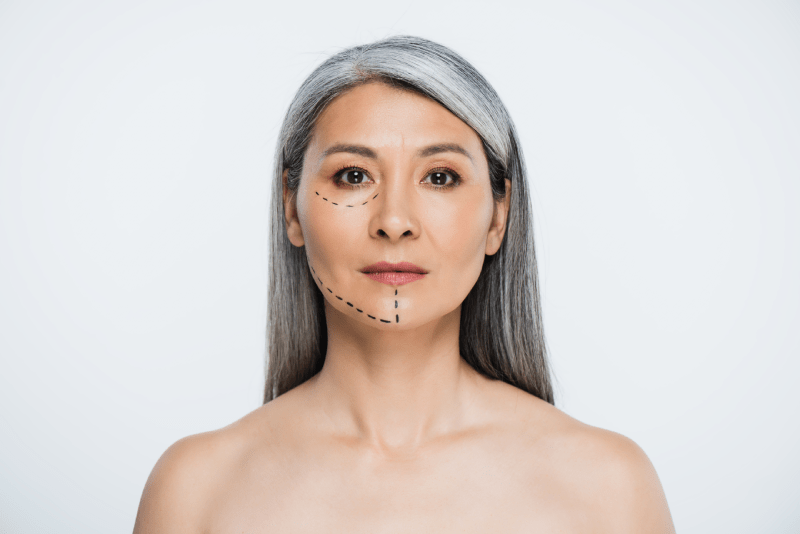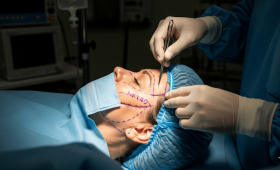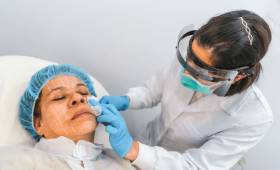What Exactly is a Face Lift Operation?
A face lift operation, also known as rhytidectomy in medical literature, is a surgical procedure aimed at eliminating the signs of aging in the face and neck area. This surgery is not just about tightening the skin; it also repositions the underlying muscle and connective tissue (SMAS layer) to achieve more permanent and natural-looking results.
Facial contours that have loosened and sagged with age, deepened nasolabial folds (lines running from the side of the nose to the mouth), and sagging along the jawline (jowl formation) are rejuvenated through this operation, and the facial contour is redefined. The surgery is typically performed through discreet incisions made in front of and around the ear, minimizing the visibility of scars.
The procedure is performed under general anesthesia and is customized according to the individual’s needs. This detailed approach promises a fresh and rested look that lasts not just a few years, but up to a decade.
Who is a Suitable Candidate for Face Lift Surgery?
Suitable candidates for face lift surgery are typically individuals who have not yet completely lost skin elasticity but are experiencing noticeable sagging and wrinkles in the face and neck area. This age range often extends from the mid-forties to the late sixties, but every patient must be assessed individually. The most important criteria are that the patient is in good general health and does not have any chronic conditions that would pose a contraindication to the surgery.
Smoking must be strictly stopped before the operation as it negatively affects the healing process. Having realistic expectations is equally important; surgery does not turn back the clock, but it significantly refreshes and improves the appearance. The patient’s psychological readiness for the process and their ability to communicate openly with the surgeon are vital for a successful outcome.
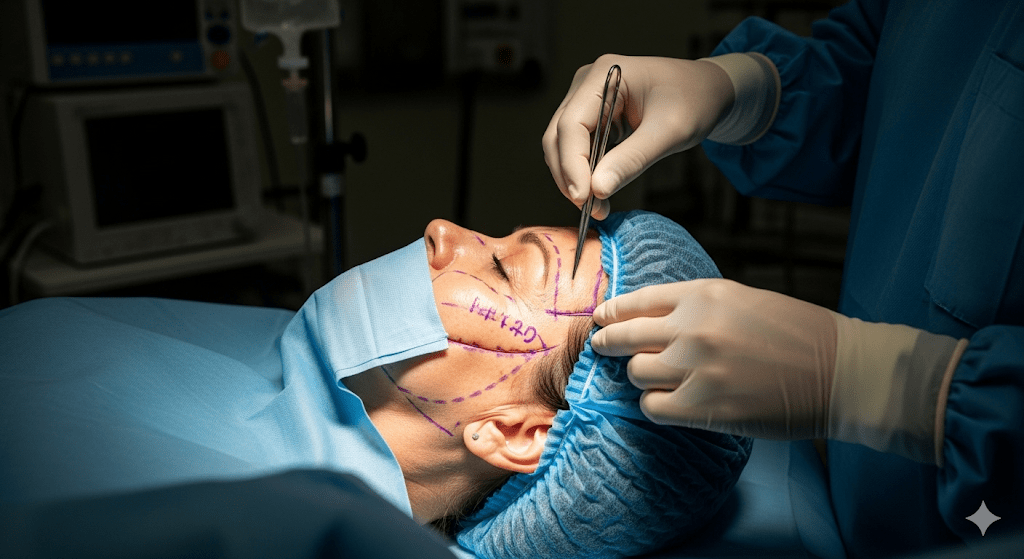
What are the Face Lift Procedures and are there Differences?
Face lift surgeries involve various procedures that can be performed at different depths and scopes, depending on the patient’s needs. A standard (full) face lift is the most comprehensive method, covering the middle and lower parts of the face and the neck. The less invasive mini face lift (mini-lift) typically targets early sagging only in the jawline and lower face area and is performed with shorter incisions.
Furthermore, a deep plane facelift can intervene in the deeper layers of the skin and underlying muscle tissue, providing more pronounced and long-lasting results; this technique is more complex and requires special expertise. Neck lift (platysmaplasty) is often combined with a face lift, correcting banding and sagging in the neck. The recovery time, the prominence of results, and the cost of each procedure differ, so choosing the right method depends on the surgeon’s expertise.
What are the Main Differences Between Mini Face Lift and Full Face Lift?
The most significant distinction between a mini face lift and a full face lift is the scope of the area treated and the length of the incision used. A mini face lift, as the name suggests, is less comprehensive; it typically uses shorter incisions around the ear and focuses only on correcting the jawline and lightly sagged cheeks. The recovery time is shorter, and it is generally suitable for younger patients showing early signs of aging.
A full face lift requires longer incisions, addressing a wide area extending from the mid-face to the lower face and neck region. It is ideal for patients with more pronounced sagging and neck wrinkles. The results of a full face lift are more dramatic and long-lasting, but the recovery process is also longer than that of a mini lift. The choice is made entirely based on the patient’s degree of aging and surgical goals.
How Long Does the Operation Take?
The duration of a face lift operation varies depending on the type and scope of the procedure performed. A simple mini face lift operation can take approximately two to three hours, while a comprehensive full face lift surgery, which includes a neck lift and other additional procedures, can take between four and six hours. If other aesthetic procedures such as eyelid lift (blepharoplasty) or fat injection are also performed in the same session, the total operation time will be extended accordingly. The length of the surgery also reflects the surgeon’s attention to detail and meticulous work. Patients are usually kept under observation in the hospital for one night, and the operation is performed under general anesthesia for comfort and safety.
What are the Potential Risks of Face Lift Surgery?
As with any surgical procedure, a face lift operation carries potential risks, although these risks are minimized when performed by an experienced surgeon. Commonly observed risks include infection, bleeding (hematoma), nerve damage (usually temporary, which can cause numbness or muscle weakness in the face), thickening of scars at the incision sites (keloid or hypertrophic scar), and risks related to anesthesia. Rarely, temporary hair loss around the hairline or asymmetry may also occur. Smoking, chronic illnesses such as diabetes, or the use of blood-thinning medications can increase the risk rate. Discussing all risks in detail with your surgeon before the operation and adhering to all instructions is the best path to a successful outcome and smooth recovery.
How is the Pain Level Managed After Surgery?
A face lift operation is generally a less painful process than patients anticipate. Patients typically report a feeling of tension, swelling, and discomfort rather than severe pain. The pain relievers prescribed by your surgeon after the operation will be sufficient to effectively control this feeling of tension and mild pain. Applying ice and keeping the head elevated for the first few days significantly increases comfort by reducing swelling and bruising. Pain management is customized according to the patient’s individual pain threshold. Most patients only require prescription painkillers for the first few days and can comfortably manage the rest of the process with over-the-counter mild pain relievers.
How Long Does the Recovery Process Take?
Although the recovery process for a face lift operation varies from person to person, there are specific milestones. The first week is when swelling and bruising are most intense, and bandages and drains (if used) are removed during this time. Stitches are removed or dissolve naturally within one to two weeks; at this point, patients usually feel recovered enough to go out in public, although slight bruising that needs to be concealed with makeup may persist. Returning to work and light activities is generally possible at the end of the second week. While approximately eighty percent of the final results of the surgery are usually visible within one to three months, it can take six months to a year for the remaining subtle swelling to completely subside and the skin to soften. Patience is the key to the recovery process.
When Can I Return to Normal Life?
The return to normal life depends on the type of work performed and the patient’s individual rate of recovery. Most office workers can return to their jobs after a two-week rest period. Bruising and swelling that occur during this time can be easily covered with makeup.
A waiting period of four to six weeks is generally recommended for jobs requiring heavy physical activity or for returning to strenuous sports. Feelings such as tension on the skin and slight numbness will decrease over time. During the first month after surgery, heavy lifting and movements that strain the face should be strictly avoided. The feeling of fully returning to a normal social life and looking in the mirror with confidence usually settles in completely around the third month.
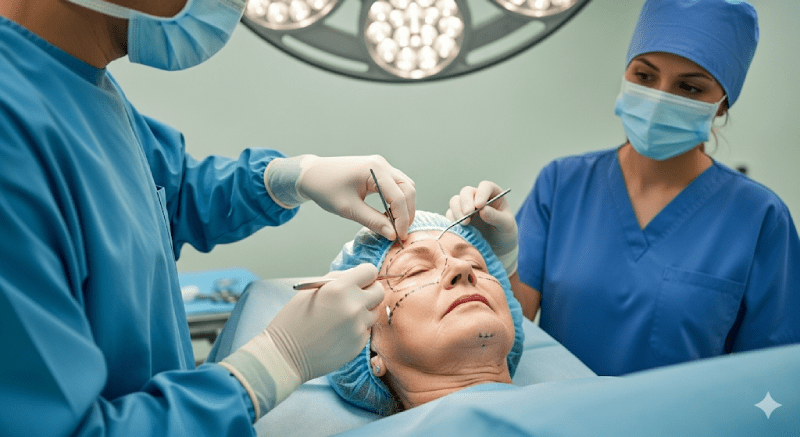
When are the Surgery Results Fully Visible?
The results of a face lift operation begin to become noticeable immediately after the surgical intervention, but these early results cannot be fully appreciated due to swelling and bruising. The initial swelling and bruising usually decrease significantly within the first few weeks.
The period when the results look “good” and the patient’s facial contours become prominent is generally around one to three months. However, the appearance of the full and final result of the surgical procedure, including the skin fully adapting, all tissue hardness softening, and even the most minor swelling subsiding, can take six months to a year. This long waiting period is necessary for the facial tissues to reshape and heal; the result will be worth your patience.
How Permanent are the Face Lift Results?
A face lift operation does not stop the aging process, but it turns back the clock, and the resulting rejuvenation effect is quite long-lasting. Results from a surgery performed with modern surgical techniques, especially deep plane techniques that intervene in the SMAS layer, can typically last for ten to fifteen years.
The permanence of the results depends on the patient’s lifestyle, genetic factors, skincare routines, and sun exposure. Regular skincare, use of sunscreen, and a healthy lifestyle help preserve the effects of the surgery for as long as possible. Even though the results are not permanent, patients will always look younger than they would have had they not had the surgery.
Can Non-Surgical Methods Replace a Face Lift?
Today, non-surgical aesthetic methods (such as fillers, botox, laser treatments, focused ultrasound, or radiofrequency) are quite popular and offer excellent solutions for early signs of aging. However, these methods cannot replace a face lift operation in advanced aging conditions characterized by significant skin sagging and deep wrinkles. Non-surgical methods can tighten the skin’s surface and add volume, but they cannot achieve the effect of lifting and repositioning the underlying tissue that surgical intervention provides. Non-surgical treatments are excellent complementary options, generally for younger patients who are not yet ready for a face lift operation or for maintaining and supporting post-surgery results.
Does Face Lift Surgery Stop Aging?
No, face lift surgery is not a magic formula that stops aging. Our body’s natural aging process continuously progresses. However, this surgical intervention dramatically reverses existing signs of aging and significantly slows down the effects of time.
After the operation, your skin and facial contours continue to age from a point that is about ten years younger than they would have been without the surgery. This means that the achieved result remains permanently on your face. Aging is a natural process, but a face lift is a strong and effective intervention against this process.
Can it be Combined with Other Aesthetic Procedures?
Face lift surgery is frequently combined with other aesthetic procedures to maximize the rejuvenation effect on the face and neck. The most common combinations include eyelid surgery (blepharoplasty), brow lift, and fat transfer (fat injection). Fat transfer is ideal for restoring lost volume due to age, especially to provide fullness to the cheeks and temples, and supports the tautness achieved by the face lift with a natural volume. Since these combinations are performed under a single anesthesia, they optimize the recovery period and holistically improve the overall aesthetic result. Your surgeon will recommend the most suitable combinations to achieve your personal goals.
When is a Revision (Repeat) Face Lift Necessary?
Revision face lift surgery is typically considered when the results obtained from the first operation begin to diminish over time or, rarely, when the desired result is not fully achieved from the initial surgery. For most patients, this is a result of the natural aging process that occurs approximately ten to fifteen years after the first operation. Revision surgery is generally more complex than the initial operation because the tissues have been previously altered and scarring is present. Therefore, choosing a surgeon who is experienced and specialized in this field is critical for a revision surgery.
What Factors Affect Face Lift Surgery Prices?
Face lift surgery prices vary greatly depending on numerous variables. The most important factors affecting the price are the surgeon’s experience and expertise (a seasoned surgeon’s fee is usually higher), the quality and accreditation of the hospital where the surgery will be performed (private hospitals are more expensive), the scope of the face lift technique applied (mini lift or full deep plane lift?), and any additional procedures included (neck lift, eyelid surgery, etc.). Furthermore, the anesthesiologist’s fee, the cost of medical materials used, and whether post-operative follow-up and care services are included also reflect in the total price.
What Should Be Considered When Researching Prices?
Focusing solely on the lowest price when researching face lift surgery costs can be a major mistake. Understanding what is included in the price is vital. You should check whether the price includes anesthesia, hospital stay, surgical supplies, post-operative bandages and medications, the fees of the surgeon and the team, and follow-up examinations.
Very low prices may indicate inexperienced surgeons, poor quality hospital environments, or hidden extra costs. The best approach is to choose facilities that offer high patient satisfaction and surgical expertise within a reasonable price range. Quality is far more important than price for such a serious aesthetic procedure.
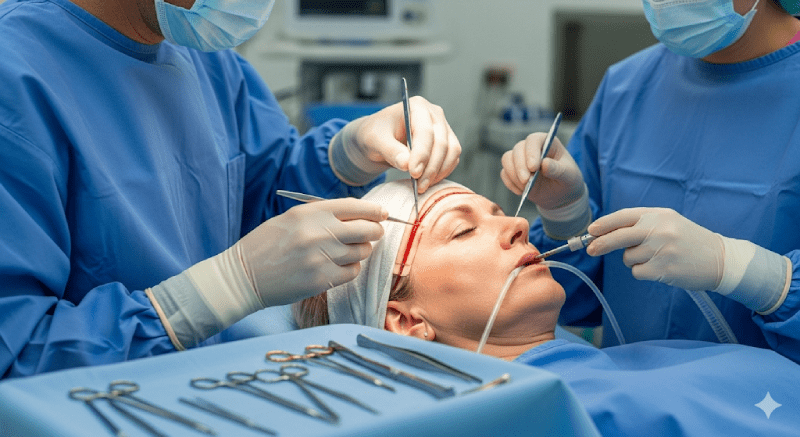
How Should One Prepare Before Having a Face Lift Operation?
Preparation before surgery is a critical phase for a successful outcome and a smooth recovery. First and foremost, you must honestly share all your expectations and medical history with your surgeon. Smoking and alcohol consumption must be strictly stopped at least two weeks before the surgery, as they slow down healing and increase the risk of complications.
Aspirin, blood thinners, and certain vitamin supplements should also be discontinued as instructed by your surgeon, as they can increase the risk of bleeding. All necessary blood tests and medical evaluations must be completed before the operation. Additionally, it is important to arrange for someone to provide support at home during your recovery period and to transform your home into a comfortable recovery space.
Why is Istanbul a World-Class Center for Aesthetic Surgery?
Istanbul is a rising star in aesthetic surgery, and there are multiple reasons for this. Firstly, Turkish surgeons receive international standard training and are members of the world’s leading surgical associations. Secondly, the technological infrastructure and modern medical equipment of private hospitals in Istanbul are comparable to those in Western-standard clinics. Thirdly, thanks to Turkey’s policies promoting medical tourism, hospitals and clinics have become highly experienced and organized in serving international patients. When combined, all these factors make Istanbul a global aesthetic center by offering both quality and affordability.
What are the Surgical Experience and Quality Standards in Turkey?
Turkey possesses a high level of expertise in the field of aesthetic and reconstructive surgery. Turkish surgeons undergo intensive training processes and are members of many internationally recognized surgical societies. In terms of quality standards, many hospitals in Istanbul have received accreditation from international bodies such as JCI (Joint Commission International); this indicates their compliance with global standards for patient safety, quality management, and medical services. As aesthetic surgery has become a daily routine practice in Turkey, surgeons’ case volume and experience are quite high. This experience translates into more successful results and fewer complications.
How are Face Lift Surgery Prices Determined in Istanbul?
Face lift surgery prices in Istanbul are generally affected by fluctuations in exchange rates and are determined according to the package content of the surgical service. Pricing varies based on the surgeon’s reputation and experience, the luxury level of the clinic where the surgery will be performed, and the inclusion of services. Furthermore, the services included in the price make a significant difference: accommodation, transfers, services of an international patient coordinator, medications, anesthesia fees, and post-operative garments. Reliable institutions that offer a transparent pricing policy prevent patients from encountering surprise additional costs. When researching prices, it is important to consider the advantages offered by “all-inclusive” packages.
Why are Istanbul Face Lift Prices More Affordable Than in Europe and the USA?
The fundamental reason why face lift prices in Istanbul are significantly lower than those in Europe, the USA, or Canada is the lower general cost of living and labor costs. The lower operational costs of surgical services and hospitals in Turkey allow the same quality of medical service to be offered at more affordable prices. This does not mean that the quality of the medical equipment used or the surgeons is compromised; on the contrary, surgeons work with international standard equipment and are highly trained. The price advantage stems entirely from the local economic dynamics and offers international patients significant savings.
How Developed is the Medical Tourism Sector in Turkey?
Turkey has one of the most developed medical tourism sectors globally. This sector, supported by the government, is specialized in meeting patients’ transportation, accommodation, treatment, and excursion needs under one roof. In Istanbul and other major cities, there are hospitals dedicated to serving international patients, multilingual staff, and professional medical coordination companies that support the patient from start to finish. Turkey welcomes millions of health tourists every year thanks to both its high-quality healthcare services and its cultural and touristic richness, ensuring processes run perfectly.
Is the Cost of Surgery in Istanbul Only the Surgical Fee?
No, the total cost of having a face lift operation in Istanbul is not just the surgical fee. When planning your total budget, in addition to the surgical fee, you need to account for expenses such as airfare, accommodation costs in Istanbul (especially the duration of your recovery period), transfer fees between the airport and the clinic/hospital, and specialized medications and bandages that may be needed after surgery. Fortunately, medical tourism agencies like Cure Holiday often offer “all-inclusive” packages that cover most of these additional costs, making budget planning extremely easy.
How Do Accommodation and Transportation Costs Affect the Budget?
In a large city like Istanbul, accommodation and transportation costs can constitute a significant part of your budget. Since you may need to stay for a few weeks during the recovery period, a comfortable accommodation option close to the hospital is essential. Medical tourism packages often include luxury hotel or special accommodation options within or near the hospital, making these costs easier to estimate. Transportation (transfers) is usually included in the packages; this eliminates the stress of searching for a taxi or navigating a foreign city. Including accommodation and transfers in the package provides a great advantage for both cost control and patient comfort.
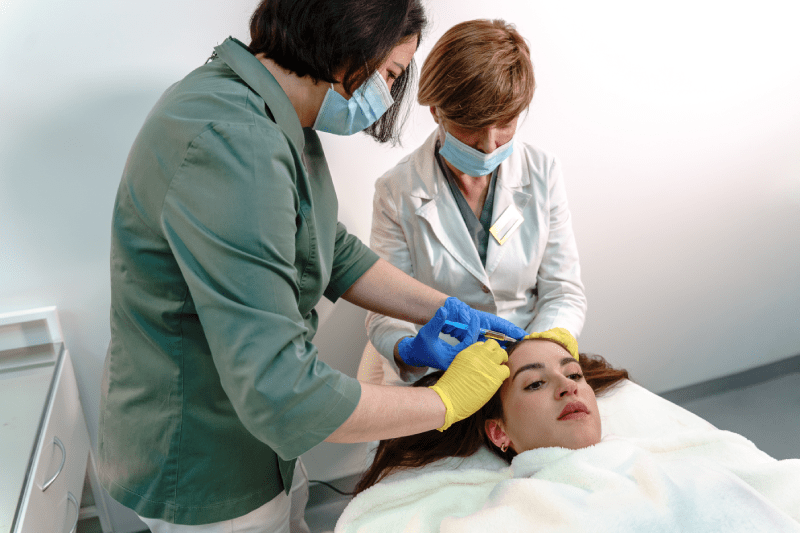
What is the Technical Equipment and Accreditation Status of Hospitals in Istanbul?
Istanbul is home to hospitals with the latest technology in the field of aesthetic surgery. Many private hospitals have technical equipment that meets or exceeds international accreditation standards (e.g., JCI). Operating rooms, sterilization protocols, and intensive care units are regulated according to the highest safety and hygiene requirements. These hospitals are designed not only for surgical operations but also to be ready for potential complications. This modern and reliable environment is critical for international patients to feel safe.
How Does the Pre-Surgery Consultation Process Work in Istanbul?
The pre-surgery consultation process for international patients typically proceeds in two stages. The first stage takes place online while the patient is in their home country. Patients send photos of their face and their medical history and speak with the surgeon via video call to discuss their expectations. This preliminary consultation helps the surgeon determine the appropriate procedure. The second and final consultation is conducted face-to-face after arriving in Istanbul, one or two days before the surgery. In this meeting, the surgeon performs a physical examination, takes final measurements, and finalizes the surgical plan. A translator or patient coordinator will accompany you during this process to avoid language issues.
Is Travel to Istanbul and Visa Procedures Difficult?
Travel to Istanbul and visa procedures are quite easy and trouble-free for most country citizens. Citizens of many countries can travel to Turkey without a visa or easily obtain an e-visa online. Travel for medical purposes is generally viewed favorably by authorities. Travel arrangements are usually facilitated by the medical tourism company. In terms of flights, Istanbul is a major international hub with direct flights from all over the world; this makes travel both fast and accessible. It is always best to check the current visa requirements before your trip.
Is the Language Barrier a Problem for Aesthetic Surgery in Istanbul?
No, the language barrier is not a serious problem for having aesthetic surgery in Istanbul. Due to the development of medical tourism, large hospitals and medical coordination companies employ professional translators and international patient counselors who provide services in multiple languages. Communication is ensured in the patient’s native language or a commonly used language throughout the entire process, from pre-surgery consultations to post-operative care. This is crucial for the patient to feel safe and to be able to fully convey their expectations to the surgeon.
How Long Should One Stay in Istanbul for Post-Surgery Check-ups?
The duration of stay in Istanbul for necessary check-ups and the initial recovery period after a face lift operation typically ranges from ten to fourteen days. This period is required for the removal of stitches, the changing of initial bandages, the surgeon’s observation of the face’s early healing, and the ability to intervene in potential early complications. After fourteen days, most patients can safely return to their home country. During this time, the patient can allocate time to both rest and explore the cultural richness of Istanbul.
Are There Places to Visit in Istanbul During the Recovery Period?
Absolutely there are. Although rest is mandatory for the first few days, light activities and short excursions can be undertaken starting from the second week. Istanbul offers many peaceful and low-tempo activities to explore during the recovery period, thanks to its rich history and culture. Strolling through the courtyards of Topkapi Palace, sitting by the Bosphorus and drinking tea, visiting the Grand Bazaar, or simply resting your soul in a Turkish bath are wonderful options to relieve stress after surgery and make the process more enjoyable. However, activities requiring heavy physical exertion or excessive sun exposure should be avoided.
How Should I Choose a Reliable Surgeon and Clinic in Istanbul?
Choosing a reliable surgeon and clinic in Istanbul is the foundation of a successful surgery. You should follow these steps when making this choice: Check the surgeon’s experience in aesthetic surgery and their specialization in this field. Research whether the hospital has international accreditations (like JCI). Most importantly, review the surgeon’s before-and-after photos of previous face lift cases. Read patient reviews and testimonials, and establish communication with the surgeon through a pre-consultation (preferably video call). Reliable medical tourism companies (like Cure Holiday) simplify this process for you by directing you to the best surgeons.
What are the Advantages of Istanbul for Patients Coming from Abroad?
Istanbul offers many unique advantages for patients coming from abroad. The most apparent advantage is obtaining medical quality at Western standards for much more affordable costs. A second advantage is that Istanbul is a cultural hub, offering the opportunity to combine the treatment process with an unforgettable travel experience. Thirdly, thanks to Turkish hospitality and the ability to organize quickly, patients feel at home and safe. Finally, Istanbul’s geographical location provides easy access from Europe, Asia, the Middle East, and Africa.
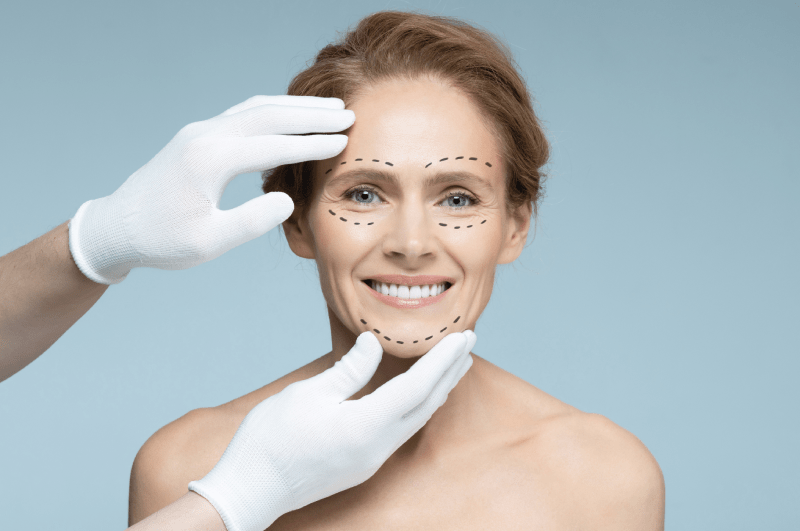
What is the Most Significant Disadvantage of Having Surgery in Istanbul?
The most significant disadvantage of having surgery in Istanbul is that you will spend the first difficult days of the recovery process away from your home and family. Although accommodation and care services are provided, the search for emotional support and comfort can be intense during the first few days. To overcome this disadvantage, medical tourism companies (like Cure Holiday) generally allow patients to bring a companion and assign coordinators to provide full support at the patient’s accommodation. This professional support aims to minimize feelings of homesickness and discomfort.
What is the Most Ideal Season for Face Lift Surgery in Istanbul?
Face lift surgery can be performed safely in any season of the year, but autumn, winter, and spring months are generally recommended for the most comfortable recovery period. Extreme heat and sun can increase swelling and cause scars to darken. Therefore, excessive sun exposure during the summer months should be avoided. Autumn and spring, when the weather in Istanbul is mild, are ideal seasons for both providing optimal conditions for recovery and for comfortable sightseeing in the city. Regardless of the season, sun protection after surgery should never be neglected.
What is Included in the Price Quotes in Istanbul?
Comprehensive price quotes provided by reliable institutions in Istanbul generally include a range of services beyond the surgical fee. These all-inclusive packages (like those offered by Cure Holiday) cover the surgery and surgeon’s fee, hospital stay, anesthesia and anesthesiologist fees, all medical materials used, post-operative medications, and initial care products. In addition, VIP airport transfers, luxury accommodation (in hotels or private units), and the service of a 24/7 accessible, multilingual personal patient coordinator who accompanies you throughout the process are also part of the package. This all-inclusive structure allows patients to focus solely on their recovery.
Why Should You Choose Cure Holiday for Your Face Lift Surgery?
Choosing Cure Holiday when making a significant decision like face lift surgery is your guarantee of getting the best experience without compromising on quality. Cure Holiday collaborates only with Istanbul’s most experienced surgeons and hospitals with international accreditations. With our years of experience in medical tourism, we offer you not just an operation, but a fully organized, comfortable, and reliable health journey from start to finish. We are with you every step of the way, from detailed pre-operative consultation to post-operative follow-up. With us, affordable treatment is combined with luxurious comfort and professional guidance.
What Do the Comprehensive Packages Offered by Cure Holiday Include?
Cure Holiday’s face lift surgery packages offer comprehensive services designed to meet all the needs of international patients. Our packages typically include the following services: The fee of the experienced surgeon and team who will perform the operation, modern hospital costs and accommodation, anesthesia fees, necessary medical tests, post-operative medication, and care supplies. Additionally, VIP airport greeting and transfer services, post-operative accommodation (usually in luxury hotels or private accommodation units), and 24/7 accessible, multilingual personal patient coordination services are also included. This all-inclusive structure allows you to focus solely on your recovery.
What Kind of Travel and Accommodation Experience Does Cure Holiday Offer?
At Cure Holiday, we ensure your medical journey is comfortable and stress-free. The moment you land in Istanbul, you are greeted by our special VIP transfer vehicle and taken to your comfortable accommodation. For accommodation, we prefer luxury hotels or private apartments that are close to the hospital and provide a suitable environment for your rest and recovery. Your comfort during the post-operative rest period is our priority. Since our treatment packages organize all your transportation between the hospital and the hotel, you won’t have to worry about navigating a foreign city.
How is Guidance and Support Provided During Your Treatment Process in Turkey?
One of Cure Holiday’s strongest assets is providing continuous guidance and support throughout your treatment process. Your assigned personal patient coordinator will be with you from the first contact until your return home. These coordinators act as translators during pre-operative consultations, manage your hospital and accommodation arrangements, organize your appointments, and answer any questions you may have. 24/7 emergency support is also provided during the post-operative period. This personal and multilingual support prevents you from feeling isolated in a foreign environment.
How to Contact Cure Holiday to Get a Price Quote?
Getting a price quote for face lift surgery with Cure Holiday is quite simple. You can reach us through our website or contact channels. As a first step, we ask you to send your general medical history and clear photos of your face. This information is reviewed by our expert surgeons. Then, your personal patient coordinator will contact you to schedule a free video pre-consultation to discuss your condition and expectations in detail. Following this meeting, a transparent and comprehensive price quote, best suited to your needs and budget, will be presented to you.
How is Post-Operative Care and Follow-up Managed with Cure Holiday?
Post-operative care and follow-up are among the stages Cure Holiday values most. During your stay in Istanbul, control examinations are organized at intervals determined by your surgeon. The removal of your stitches, changing of your dressings, and monitoring of your general recovery are carried out meticulously. The follow-up process continues after you return to your home country. Your surgeon and patient coordinator remain accessible through remote communication channels, allowing you to find answers to your questions even in the later stages of your recovery. This long-term follow-up is critical for maintaining the quality of the result achieved.
What is the Guarantee of Your Aesthetic Journey with Cure Holiday?
Cure Holiday offers the guarantee that your aesthetic journey will take place under the highest standards and in complete safety. Our assurance is based on our collaboration only with JCI accredited or equivalent quality hospitals, and our partner surgeons being internationally recognized and experienced. Furthermore, the securing of your entire treatment process with a transparent contract and our pre-planned support mechanisms for potential complications give you peace of mind. When you work with us, you choose not only the best surgical results but also a partner that protects international patient rights.
